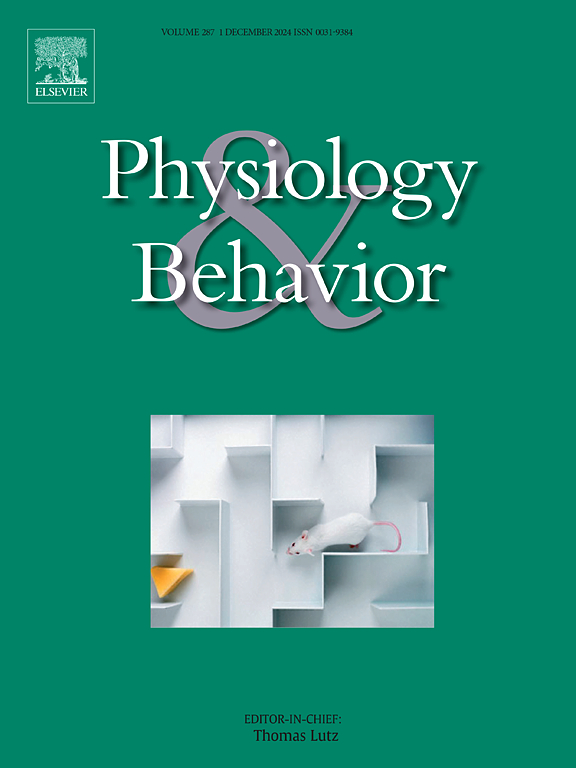The role of vasopressin deficiency in the fluid intake suppression hyper-responsivity to central glucagon-like peptide-1 in the Brattleboro rat
IF 2.5
3区 医学
Q2 BEHAVIORAL SCIENCES
引用次数: 0
Abstract
Food and fluid intakes are physiologically and behaviorally intertwined; one often affects the other. Likewise, pharmacological manipulations that influence eating often affect drinking. For example, glucagon-like peptide-1 (GLP-1) suppresses both eating and fluid intake, but the respective elements of the GLP-1 system remain unparsed. The Brattleboro rat has emerged as a model to test for separable elements in the control of fluid or food intake. Brattleboro rats have hereditary hypothalamic vasopressin deficiency. To compensate for the resultant polyuria, they drink copious amounts of water. Eating, however, is similar to that observed in wildtype littermates and other Long Evans rats. Interestingly, treatment with a GLP-1 receptor agonist exendin-4 (Ex4) causes an exaggerated suppression of drinking in Brattleboro rats, but suppression of eating is comparable to wildtype controls. To test if this hyper-responsivity depends on the polydipsia in these rats, we normalized their drinking using desmopressin (ddAVP), a V2R agonist, before treatment with Ex4. ddAVP attenuated, but did not completely prevent, the hyper-responsivity to Ex4. Conversely, we treated wildtype rats with acute or chronic tolvaptan, a V2R antagonist, which generated a Brattleboro-like polydipsia, but this did not recapitulate the hyper-responsivity to Ex4 observed in Brattleboro rats. Based on these results, we conclude that polydipsia alone is insufficient to generate a hyper-responsive fluid intake suppression by Ex4, and that Brattleboro rats have at least some persistent hyper-responsivity to Ex4, even after alleviation of their polydipsia. These results provide important context for future studies using Brattleboro rats to study the GLP-1 system.
抗利尿激素缺乏在液体摄入抑制中央性胰高血糖素样肽-1的高反应中的作用。
食物和液体的摄入在生理和行为上是相互交织的;一个经常影响另一个。同样,影响饮食的药理学操作通常也会影响饮酒。例如,胰高血糖素样肽-1 (GLP-1)抑制饮食和液体摄入,但GLP-1系统的各自元素仍未被解析。伯瑞特伯勒大鼠已经成为测试控制液体或食物摄入的可分离因素的模型。伯氏大鼠有遗传性下丘脑抗利尿激素缺乏症。为了补偿由此产生的多尿,他们喝大量的水。然而,进食与在野生型幼崽和其他朗埃文斯大鼠中观察到的相似。有趣的是,用GLP-1受体激动剂exendin-4 (Ex4)治疗会导致Brattleboro大鼠对饮酒的过度抑制,但对饮食的抑制与野生型对照相当。为了测试这种高反应性是否取决于这些大鼠的多饮,我们在使用Ex4治疗前使用去氨加压素(ddAVP)(一种V2R激动剂)使其饮酒正常化。ddAVP可减弱但不能完全阻止Ex4的高反应性。相反,我们用急性或慢性V2R拮抗剂tolvaptan治疗野生型大鼠,产生Brattleboro样多饮,但这并没有重现在Brattleboro大鼠中观察到的对Ex4的高度反应。基于这些结果,我们得出结论,烦渴本身不足以产生Ex4对液体摄入的高反应性抑制,并且即使在烦渴缓解后,Brattleboro大鼠至少对Ex4有一些持续的高反应性。这些结果为今后利用Brattleboro大鼠研究GLP-1系统提供了重要的研究背景。
本文章由计算机程序翻译,如有差异,请以英文原文为准。
求助全文
约1分钟内获得全文
求助全文
来源期刊

Physiology & Behavior
医学-行为科学
CiteScore
5.70
自引率
3.40%
发文量
274
审稿时长
47 days
期刊介绍:
Physiology & Behavior is aimed at the causal physiological mechanisms of behavior and its modulation by environmental factors. The journal invites original reports in the broad area of behavioral and cognitive neuroscience, in which at least one variable is physiological and the primary emphasis and theoretical context are behavioral. The range of subjects includes behavioral neuroendocrinology, psychoneuroimmunology, learning and memory, ingestion, social behavior, and studies related to the mechanisms of psychopathology. Contemporary reviews and theoretical articles are welcomed and the Editors invite such proposals from interested authors.
 求助内容:
求助内容: 应助结果提醒方式:
应助结果提醒方式:


